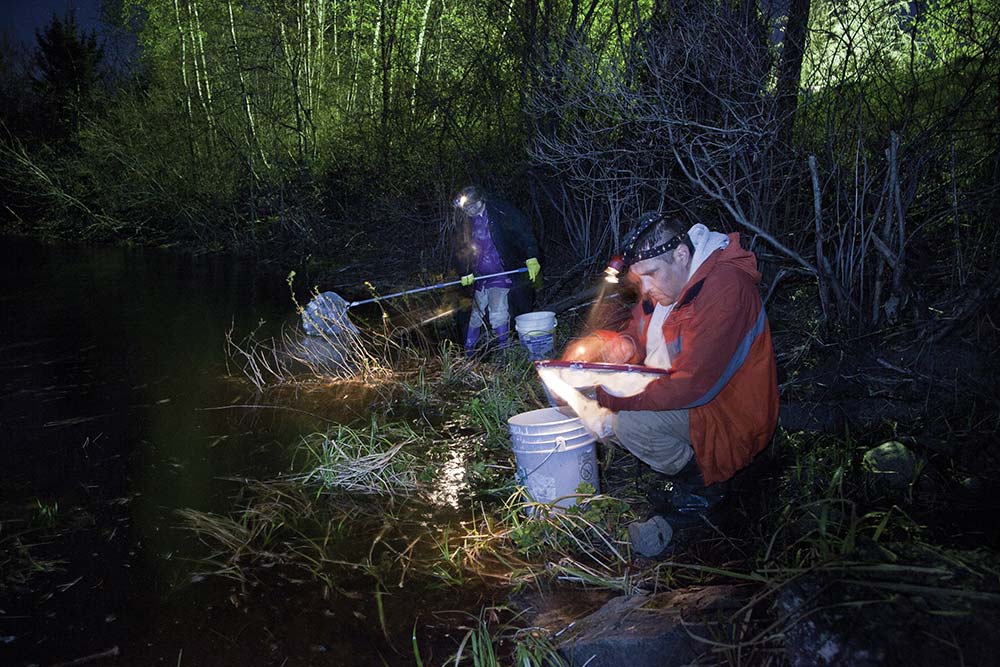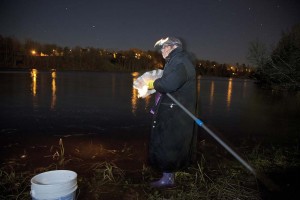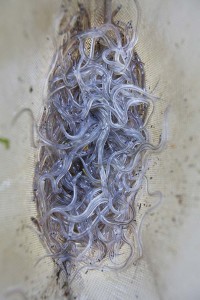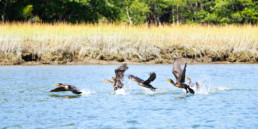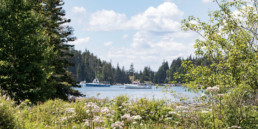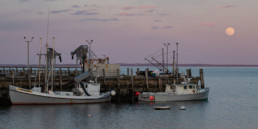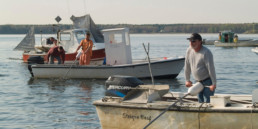The Passamaquoddy Alternative
On a moonless November night, the rain-swollen St. Croix River flows unseen through the forests of eastern Maine and western New Brunswick. The river passes through the darkness almost by feel, and dozens of female American eels—silver eels, as they are called—snake along the bottom with the current, their noses toward the sea.
The American eels—Anguilla rostrata—are catadromous, meaning that they live in fresh- and brackish water, and spawn in the open ocean. On the St. Croix, their journey of a thousand miles begins with running a gauntlet of hydroelectric turbines at the Grand Falls and Woodland dams, and finally Milltown, where the lights of the New Brunswick (NB) Power generating station cut open the night. The dam there forces the entire volume of the St. Croix River, over 200 tons of water an hour, through three generating units with dozens of blades spinning at up to 200 rpms. The eels, driven by the equally powerful need to reach salt water, swim heedlessly into the suction of the turbines that may cut them to pieces.
Fifty miles to the west, luckier eels pass unmolested through the torrent of Bad Little Falls on the Machias River. Above the falls, on this drizzling November night, the Passamaquoddy tribe’s Truth and Reconciliation Commission (TRC) holds a public meeting on the campus of the University of Maine at Machias.
In a warm, well-lit auditorium, Denise Altvater tells a very personal story of how the State once systematically removed children like her from their homes at the Pleasant Point Indian reservation known as Sipay’k to the Passamaquoddy people, justifying the action as a way to improve their educational and economic plight.
“I was only five years old, and had hardly been off the reservation,” she says. “Imagine how it felt when these cars full of strangers drove in and they took me and my sisters and put us in those cars. My parents could do nothing.”
Altvater describes 10 years of abuse in those homes: beatings, hunger, and later, rape, before being returned to her reservation home at age 15.
Esther Altvater Attean, co-director of the TRC, offers a litany of atrocities perpetrated against her people, reminding the primarily white audience that the ground the university stands on was taken from her tribe. “Ninety percent of our people were wiped out,” Attean says.
The Passamaquoddy and other indigenous people happened to be in between a new world order and the natural resources it needed. What might be called a culture of depletion has eclipsed an indigenous culture of respect. Though less tragic than seizing children from their parents, the conflict between Native values and an expanding colonial economy also left the tribe a victim, many Passamaquoddy members believe.
AN ONGOING TRADITION OF FISHING
Shell middens along the St. Croix bear testimony to millennia of healthy fisheries that preceded Samuel Champlain’s sailing up the St. Croix in 1604 to establish the French colony, Acadia. My own grandfather 11 generations back, Charles de la Tour, arrived in the region with Acadia’s new governor de Poutrincourt in 1606. After two years living with the Mi’kmaq, he built forts at what are now St. John, New Brunswick, and Castine, where his company traded guns and steel for furs. He spoke the local Native languages.
But he also helped to introduce the tribes to European diseases, inadvertently, and deliberately, to the European economic system, which relied on the plunder of fisheries and forests, and on the often-violent reallocation of resource access to the wielders of the most advanced technology.
“I call it ‘privileged exploitation,’ ” said Fred Moore III, a member of the Passamaquoddy Fisheries Advisory Committee.
Non-Native fishing communities on the coast also have felt at least some of the bite of this system. In the last half-century, weir fishermen lost the herring fishery to purse seiners, who lost it to mid-water trawlers. When resources decline and fishing cultures are reduced to exhibits in shoreside museums, the prevailing narrative calls it progress. Aside from lobster, however, Maine has progressed steadily down the road of fisheries decline.
In rural Downeast fishing communities, many fishermen once eked out a living by scalloping, harvesting sea urchins, picking periwinkles, and clamming. They fished for cod, haddock, pollock, and mackerel within sight of their homes, and herring weirs dotted the coastline. On a local level, all of those enterprises have disappeared or are slipping toward economic and cultural irrelevance.
State management plans, usually based on free-market theory and the mantra “Too many fishermen, too few fish,” have not given adequate consideration to habitat issues, while permitting unsustainable harvest levels and the consolidation of resource access into the hands of fewer and fewer players. Landings in all of the important inshore fisheries, aside from lobster, have either declined or plummeted. Like the Passamaquoddy, cod have lost over 90 percent of their populations.
The Passamaquoddy occupy the oldest fishing community on the coast of Maine—thousands of years older than any other—and many members of the tribe believe survival depends on direct access to resources, along with the culturally relevant knowledge of how and when to use them.
“The name Passamaquoddy means, ‘People who spear pollock,’ ” said Moore, who also is the primary author of the tribe’s newly developed fisheries management plan. “It’s who we are. We are inextricably tied to the sea.”
The Passamaquoddy fisheries plan aims to restore habitat, harvest seafood responsibly, and broaden fisheries access; it includes specific management plans for many species. Scallops, lobster, groundfish, alewives, and the lucrative elver fishery all play a role in the future health of a fishing community thousands of years older than the state. “Our cultural norms are codified in our plan,” said Moore. “We don’t exploit resources; we utilize them.”
For Moore, change does not mean going back in time, nor does he plan to assimilate. Looking for a way to provide a future for his children and the tribe, Moore is training his sons and other tribal members as lobstermen, and moving toward getting scallop boats offshore. His management plans continue to take shape, garnering input from elders and the fisheries advisory council. Among other things, he has proposed reducing the trap limit for the tribe’s lobstermen and increasing the number of lobster licenses the tribe issues.
In addition, Moore’s company, Native Harvest Seafood, has begun preliminary work on an eel-farming project to add value to the elver (or “glass” eel) harvest, and to use surplus production to help restock local watersheds.
“The State doesn’t want us to have an LNG terminal, or casinos, so we’re expanding our fisheries,” he said.
THREAT FROM GOVERNOR
Moore and other Passamaquoddy fishers have hunted porpoise, declared their intentions to operate larger vessels in the area that stretches out to Georges Bank, and Moore regularly sets his lobster gear on both sides of the international border between the United States and Canada. None of that has caused much reaction.
But when the tribe issued 575 eel-fishing permits in the spring of 2013, Governor Paul LePage accused hundreds of Passamaquoddy eel harvesters of violating state law. According to Moore and other Passamaquoddy leaders, the governor threatened to withdraw support for issues important to the tribe, such as the TRC and economic development initiatives.
A heated confrontation took place in March 2013 on the Pennamaquan River. Maine Marine Patrol officers, with backup from state police, confiscated nets and issue some summonses, all of which have been dismissed.
In the 1980 Indian Land Claims Settlement, the Passamaquoddy agreed to relinquish any “right involving such land or natural resources.” Speaking at the Maine Food Summit in December 2013, Pat Keliher, commissioner of the Department of Marine Resources (DMR), said the tribe has in effect surrendered its rights to any fisheries not specified in past treaties.
“Treaty-shmeaty,” said Moore. “Our rights don’t come from a treaty. They are part of us, and part of our collective consciousness stretching back for hundreds of generations. Remember when people wanted to bring the wolves back to Maine, and there were those bumper stickers, no wolves? Well, as far as the DMR is concerned, we’re the wolves.”
A FISHERY RENAISSANCE
In spite of the threat of State legal action, Moore believes the biggest challenge to creating an eel fishery based on traditional knowledge may come from within the tribe itself. Historically, threatened communities are often caught in a dilemma where strength depends on a united front, yet any member can betray the common good for personal gain. In addition, Moore believes that reliance on dividends from the tribe’s investments may reduce reliance on past cultural practices.
“The eel fishery represents the essence of our spiritual connection to the Earth,” Moore said. “When a Passamaquoddy child is carried to the banks of a river by a Passamaquoddy woman, to harvest a resource, that is a continuation of thousands of years of culture. But in order to maintain our rights we must occupy the moral high ground. The plan has to be adhered to and enforced.”
Besides harvest limitations, the glass eel fishery plan includes stiff penalties for those who forget what Moore described as “their cultural obligation to protect the resources.”
In what might be called a Passamaquoddy fisheries renaissance, other members of the tribe have taken up the cause of a fish that has long sustained coastal communities, both physically and culturally.
“For seventeen years the Maine Legislature unilaterally blocked alewives from entering the St. Croix watershed, what we call the Schoodic River,” says Brian Altvater, cofounder of the Schoodic Riverkeepers. “The state of Maine cut the alewives off from 98 percent of their spawning grounds,” he said, “just to protect smallmouth bass—which were brought into the Schoodic watershed in 1877. Between 1987 and 2002, the St. Croix alewife run collapsed from 2.6 million fish to a mere 900. And they were able to get to our leaders and get them to support this.”
After 2002, the Canadian Department of Fisheries and Oceans, working with NB Power, caught and trucked alewives to the waters above the Milltown dam. Altvater believes this prevented the species from becoming extinct. In 2011 he helped to start the Schoodic Riverkeepers, a group responsible for a renaissance within the joint tribal council that has led to the state reopening the St. Croix to alewives in May 2013.
Passamaquoddy chief Hugh Akagi believes the Native people were put in an untenable position.
“Never again should indigenous people be involved in blocking an indigenous species from its homeland,” he says. “This is what has been done to us.”
Altvater agrees.
“The parallels are there. This is our land, but we are constrained by others’ standards. The same for the alewives; forcing them to stay below the dams isn’t working,” he said. “They need to swim free.”
Altvater notes numerous studies that show better bass production in watersheds that allow passage of alewives, which serve as a nutrition pump, bringing the wealth of the sea far inland in their flesh. “These fish, because they are so prolific, feed other species of fish, eagles, otters—you name it,” he said.
Ted Ames, who won a MacArthur Grant for his study of historic inshore groundfish habitat, vigorously supported the restoration of alewives, largely because of their importance to cod. “When the alewives are there, the cod are there,” said Ames, who, in the 1970s and ’80s, often sailed to the St. Croix in the fall to fish on concentrations of cod and flounder.
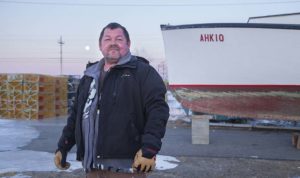
EELS AGAINST THE ODDS
Unlike the alewives, mature American eels swim downstream on their spawning migration, and like everything else coming out of the river, they go through the turbines at Grand Falls, Woodland, and Milltown. While observers guess that the millions of 3-inch-long juvenile alewives lose about 5 percent of their number in the turbines, the few 30-inch eels making the passage often fare worse.
“I’ve seen plenty of eels below the dams,” said Fred Moore. “But they’re all about this long,” he said, holding his hands a few inches apart.
Those same eels made their upstream journey many years before, drifting and swimming from nursery grounds in the Sargasso Sea to the rivers and lakes of Maine. And the little transparent glass eels hardly needed help getting over the dams, observes NB Power’s hydro manager, Phillip Gilks. “They are very diligent. If there’s a crack in the concrete, they come through it. I’ve seen them coming through joints in the masonry.”
But Gilks cannot offer any assessment on how many mature eels make it out of the river. “I know there’s always elvers coming back,” he said.
Elvers do not have fidelity to any particular waterway, however. Eels are panmictic—free spawners—and their young are born in the open ocean. The parents of the elvers that enter the St. Croix might well have come down the Machias River, or the Potomac, for that matter.
“We know the eels don’t pass through the turbines as easily as alewives,” said Gilks.
An avid outdoorsman, Gilks expressed regret about the situation. “But at the moment we do not have a way to help. We cannot afford to do the research. We’re waiting to see if someone comes up with the technology to get the eels by. When they do, we’ll use it.”
Every mother eel that gets sushied in the hundreds of hydroelectric dams on the Eastern Seaboard dies with anywhere from 2 million to 15 million eggs in her ovaries. Her reason for being, the culmination of 20 years of survival in the wild, lost without a eulogy. Eagles and gulls congregate below the dam and clean up the evidence.
According to Ken Oliveira, an eel expert at the University of Massachusetts, eels that survive the external obstacles may face insidious internal obstacles.
“Some carry a swim bladder parasite, Anguillicoloides crassus, an invasive nematode worm from Asia,” says Oliveira. The parasite arrived in North America via Europe, likely in the ballast water of transatlantic freighters, and it can prevent eels from diving to great depths—which may be an important part of their sexual maturation process.
“That’s just one strike against them,” Oliveira said. “Almost all eels have bioaccumulated PCBs, mercury, and other endocrine disrupters that have proven to reduce the viability of their eggs.”
Providing healthy habitat for all sea-run species—eels, alewives, and salmon, which already may be extinct from the St. Croix—plays an important part of the Schoodic Riverkeepers’ plan.
“Our next goal is to improve water quality, moving toward total restoration of the watershed,” said Altvater.
Genocide can be as much a factor of negligence as intent, but the results look the same. For the Passamaquoddy Truth and Reconciliation Commission, healing needs to take place on many levels—personal, social, and environmental, to name a few—but not everyone shares the same enthusiasm for the task.
When asked what non-Native people can do, Denise Altvater turned to the audience in Machias that night in November and smiled. “Whatever you can. You can listen, and work on your own racism,” she added.
Making sense of that advice requires a clear view of history. “When I hear other lobstermen brag about coming from six or seven generations of fishermen, I have to laugh,” Fred Moore said. “I say, ‘Oh yeah? I come from two hundred generations.’ ”
As Ester Altvater Attean reminded the audience at the Machias TRC meeting, “Your prosperity has depended on the removal of our people.”
Moore sees a similar pattern unfolding in the fisheries.
“As competition for depleted resources increases,” he said, “so do the opportunities for conflict.” Maine’s coastal communities seeking to create real wealth to share with everyone can continue the conflict-prone management strategies generated by the introduced economy of privileged exploitation. But if they want to cultivate a healthy resource base, accessible to as many fishers as possible, they may want to consider adopting a more-indigenous approach to resource management. It begins with respect for all things, including each other and the ecosystem we all depend on.

